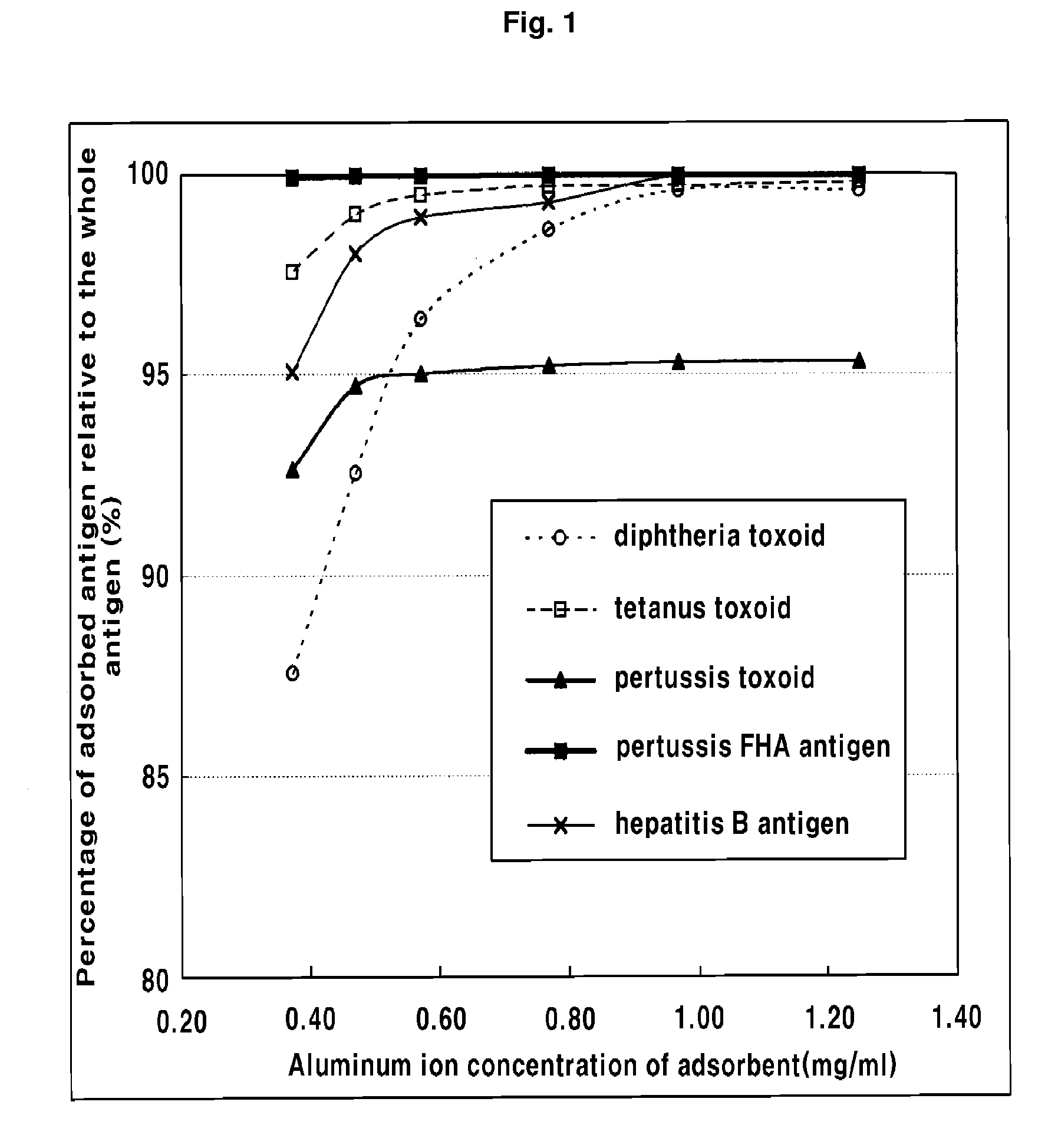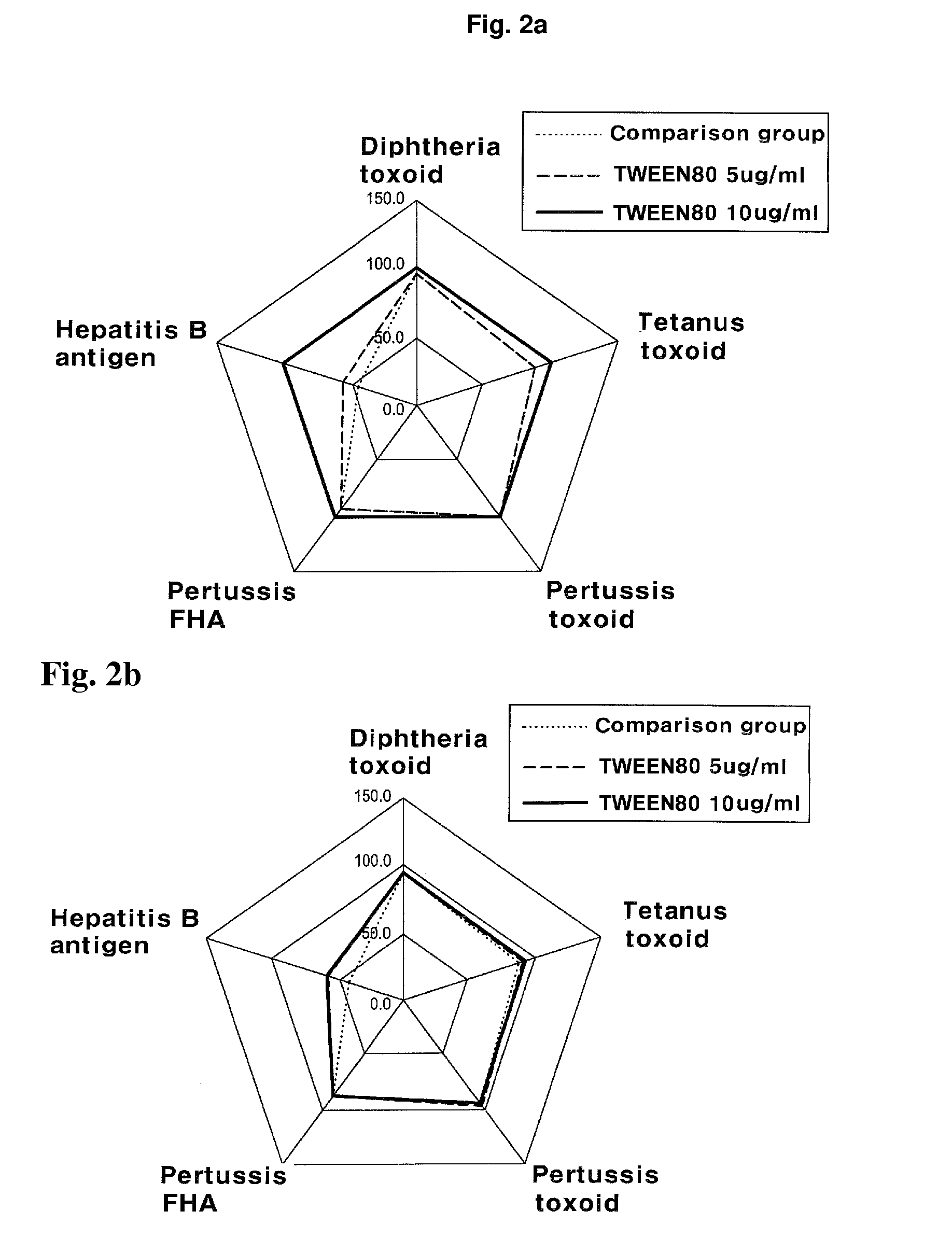Manufacturing Method of Combined Vaccine
a combined vaccine and manufacturing method technology, applied in the field of combined vaccine manufacturing method, can solve the problems of overlapped shots, inability to perform research with respect to the variation of immunity, side effects,
- Summary
- Abstract
- Description
- Claims
- Application Information
AI Technical Summary
Benefits of technology
Problems solved by technology
Method used
Image
Examples
example 1
Manufacture of Hepatitis B Antigen
[0045]The yeast cell which is capable of expressing the hepatitis B surface antigen by genetic engineering method is intensively cultivated. 1 kg of the precipitate of yeast cells which is obtained by the centrifugation is diluted at a ratio of 1:2 in a buffer solution (0.5M NaCl, 10 mM EDTA, 0.01% Thimerosal, 0.1M Phosphate, pH 7.0). The diluted solution flows through a glass bead beator (or Dynomil) for thereby breaking cell walls and so on. The obtained solution is added with a neutral surfactant (TWEEN® group or TRITON® group) by 0.5% and is uniformly mixed by stirring at 4° C. Sodium hydroxide was added to the resultant solution for thereby obtaining pH 11 and is then mixed by stirring at 4° C. for 5 hours. A diluted hydrochloric acid was added to the resultant solution for thereby obtaining pH 4. The precipitate was removed by a centrifugation at 6000 rpm for 15 minutes using the centrifugal machine (ROTOR: JA-14, Beckman Inc. USA), and the up...
example 2
Manufacture of Diphtheria Toxoid
[0046]The Corynebacterium diphtheria PW No. 8 was cultured at 35° C. for 24 hours in the nutrition agar culture medium (DIFCO, USA) and was subcultured two times. One of the colony was cultured at 35° C. for 24 hours in 2 ml of the brain heart infusion culture medium (DIFCO, USA), and 1.2 ml of it was inoculated to the modified Muller culture medium (refer to: Stainer, et. al, Canadian J. Microbiol., 14:155, 1968) of 300 ml and was cultured at 35° C. for 36 hours. After the culture, cells were removed from the culturing solution, and the toxin solution was collected and it was added with ammonium sulfate at 4° C. The final concentration was made in 25(w / v) %, and pH was made in 8.0. The culturing solution having adjusted pH and concentration of salt was dropped into the phenyl-SEPHAROSE bead column which was previously balanced using 10 mM tris buffer solution pH 8.0 including 25 (w / v) % ammonium sulfate. The buffer solution same as the column balance...
example 3
[0047]The Clostridium tetanii (Harvard strain) was cultured by molten agar method with sterilized liver-bile agar medium (DIFCO, USA). A few colonies from above culture were inoculated into brain heart infusion culture medium (DIFCO, USA) including 0.3 (w / v) % yeast extraction (DIFCO, USA) of 2 ml having decreased oxygen level and were cultured at 35° C. for 24 hours in anaerobic state. And then, the culture solution was inoculated into fully nitrogen-saturated brain heart infusion culture medium (DIFCO, USA) 500 ml including 0.3 (w / v) % yeast extraction (DIFCO, USA) and were cultured at 35° C. for 7 days in anaerobic state. After the culture, cells were removed from the culture solution, the toxin solution was collected and added with ammonium sulfate at 4° C. for thereby obtaining the final concentration of 60 (w / v) % and was mixed for over 24 hours and was fully mixed for thereby obtaining a precipitate by centrifugation. The precipitate was dissolved...
PUM
| Property | Measurement | Unit |
|---|---|---|
| concentration | aaaaa | aaaaa |
| concentration | aaaaa | aaaaa |
| concentration | aaaaa | aaaaa |
Abstract
Description
Claims
Application Information
 Login to View More
Login to View More - R&D
- Intellectual Property
- Life Sciences
- Materials
- Tech Scout
- Unparalleled Data Quality
- Higher Quality Content
- 60% Fewer Hallucinations
Browse by: Latest US Patents, China's latest patents, Technical Efficacy Thesaurus, Application Domain, Technology Topic, Popular Technical Reports.
© 2025 PatSnap. All rights reserved.Legal|Privacy policy|Modern Slavery Act Transparency Statement|Sitemap|About US| Contact US: help@patsnap.com



